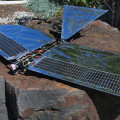“How can Robo Raven ‘feed’ itself in jungles?” asks SK Gupta, University of Maryland robotics expert, on his “Unorthodox Ideas” blog. The answer follows his question. The bird drone that researchers in the university’s Robotics Center created is the newest incarnation of their bird drone, the Robo Raven micro air vehicle (MAV) that carries solar panels in its wings. And they flap.
While the solar panels don’t produce enough energy to power Robo Raven III in flight (they produce around 3.6 Watts while Robo Raven needs around 30 Watts to fly), they are effective in charging the MAV’s batteries when it is stationary.
Gupta notes that the development team envisions Robo Raven flying far away from civilization during long missions. “These new multifunctional wings will shape the future of robotic birds by enabling them to fly longer, farther, and more independently because they will be getting their power from the sun,” says Ph.D. student Luke Roberts, a member of the Robo Raven team.
The underlying material of the flexible solar panels is different from that used in the previous version of Robo Raven. That meant the team needed to design new wings and develop a new additive manufacturing process to fabricate them, Gupta says.
“We still need to make significant improvements in solar cell efficiency and battery energy density to replicate the endurance of real ravens in Robo Raven III,” Gupta says, “but the good news is that Robo Raven III has already demonstrated we can fly with a solar cell and battery combination. Now that we’ve successfully taken this step, swapping new technologies that are more efficient should be relatively simple.”
Gupta has been working on flapping-wing robotic birds for about a decade. His team first successfully demonstrated a flapping-wing bird in 2007. An earlier version of Robo Raven needed to be plugged into an electric socket for charging the battery. This spring the group introduced Robo Raven, the first flapping-wing MAV with independently flapping, programmable wings.
 TEXTILES.ORG
TEXTILES.ORG





